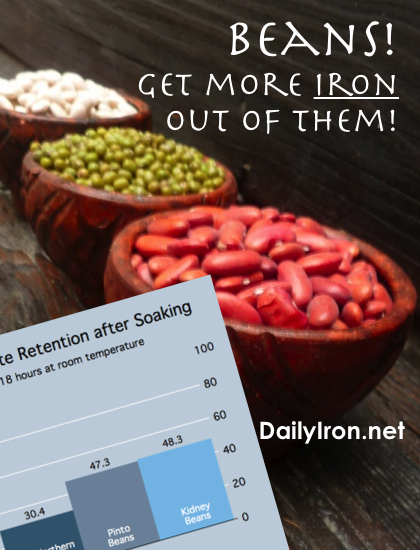 Beans tend to be a high iron food and are a key source of iron in many people’s diet however beans are high in a substance that inhibits iron absorption: phytic acid. There is a good bit of evidence from the fields of food science and nutrition that phytic acid does inhibit iron and that reducing it can make a positive impact on health. In the case of beans, there is an extremely simple solution that will actually help you in your food preparation: soak your beans to reduce phytic acid.
Beans tend to be a high iron food and are a key source of iron in many people’s diet however beans are high in a substance that inhibits iron absorption: phytic acid. There is a good bit of evidence from the fields of food science and nutrition that phytic acid does inhibit iron and that reducing it can make a positive impact on health. In the case of beans, there is an extremely simple solution that will actually help you in your food preparation: soak your beans to reduce phytic acid.
Soaking beans will reduce phytic acid and your beans will cook faster. Ideally, you will plan to cook beans the day before, soak them over night, and have them cooking for lunch or dinner.
Phytic Acid in Food and Iron Absorption
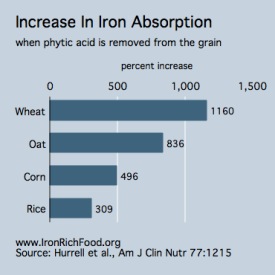 As inspiration that reducing phytic acid in food, check out the results of a study on grains. Food scientists removed phytic acid from wheat, oats, corn, and rice and saw an increase in iron absorption of between 300% and 1100%. On the low end of the scale, you triple your iron by reducing phytic acid. Of course, you probably will not reduce the phytic acid in your beans to zero in your kitchen, but you can certainly make a dent in it.
As inspiration that reducing phytic acid in food, check out the results of a study on grains. Food scientists removed phytic acid from wheat, oats, corn, and rice and saw an increase in iron absorption of between 300% and 1100%. On the low end of the scale, you triple your iron by reducing phytic acid. Of course, you probably will not reduce the phytic acid in your beans to zero in your kitchen, but you can certainly make a dent in it.
Soaking Beans to Reduce Phytic Acid
If you read nothing else, here is your take-home:
Soak your beans overnight in warm water.
Below you can explore results from food science on time and temperature, but if you can set up a system in your kitchen in which your beans are soaking over night (or even for 24 hours) in warm water, you are ahead of the game. Your beans will provide you with more iron and they will cook more quickly.
Before getting to the nitty-gritty, I have gotten a lot of questions over the years about beans, particularly from people who forgot to soak them and did not know what to do. Some people have turned to canned beans because they are lower in phytic acid. It is true that the canning process lowers phytic acid but as a whole foods bean-lover myself, my problem with canned beans is the canned part. For my part, I would cook the beans without having soaked them in a pinch. (Though in much of a pinch you will probably need a pressure cooker to do so.) The purpose of this article is not to make you a slave to soaking or to getting phytic acid as close to zero as possible, but to suggest you implement this very simple kitchen strategy into your everyday cooking to improve your iron absorption.
Effectiveness of Soaking Beans
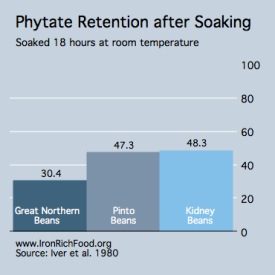 One interesting study examined the retention of phytic acid in three different beans after soaking for 18 hours at room temperature. Great northern beans maintained 30% of their original phytic acid content, pinto beans 47% and kidney beans 48%. These results are better than cooking alone and better than germinating beans. Soaking is a good strategy. However, we can do even better.
One interesting study examined the retention of phytic acid in three different beans after soaking for 18 hours at room temperature. Great northern beans maintained 30% of their original phytic acid content, pinto beans 47% and kidney beans 48%. These results are better than cooking alone and better than germinating beans. Soaking is a good strategy. However, we can do even better.
There was a great little study that varied the temperature of the soaking water and found that soaking beans in warmer water was more effective. The optimum temperature in the study was 140 degrees Fahrenheit.
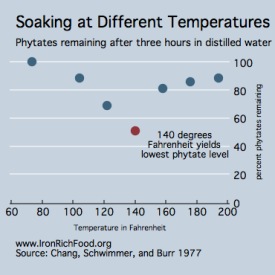 That is quite warm for most of our kitchens. Some people have managed this in a crockpot with success; others have probably gotten close to this under a pilot in their oven. Some people have reported that their beans have begun to ferment spontaneously. I thought that was really cool but if soured beans are not what you are going for, you could get far too much funk for your own preference.
That is quite warm for most of our kitchens. Some people have managed this in a crockpot with success; others have probably gotten close to this under a pilot in their oven. Some people have reported that their beans have begun to ferment spontaneously. I thought that was really cool but if soured beans are not what you are going for, you could get far too much funk for your own preference.
My Method
The method I use in my kitchen is extremely simple and should work for everyone. I put my beans in a large stainless steel bowl and add extremely warm water — probably about 140 degrees. I never measure the temperature, but it is warm without burning my hands. I achieve the temperature by warming some water in a tea kettle and adding that hot water plus cool water from the tap to the bowl of beans. As the beans take in water and as the water cools in the bowl, I add more warm water. From there, I do not worry about the beans, water, or temperature. I just let them soak. I start the beans the night before either lunch or dinner the next day.
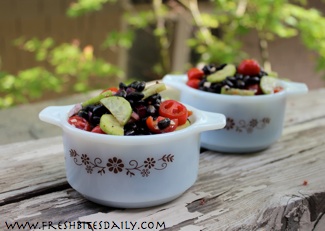 You might want to play with maintaining a higher temperature, particularly if you need the iron but using my method is certainly far better than nothing.
You might want to play with maintaining a higher temperature, particularly if you need the iron but using my method is certainly far better than nothing.
Ideally, you will pair your beans with vitamin C foods as well such as the bean salad pictured above. The tomato and cucumber will help you absorb more iron and, of course, they happen to taste great too.
